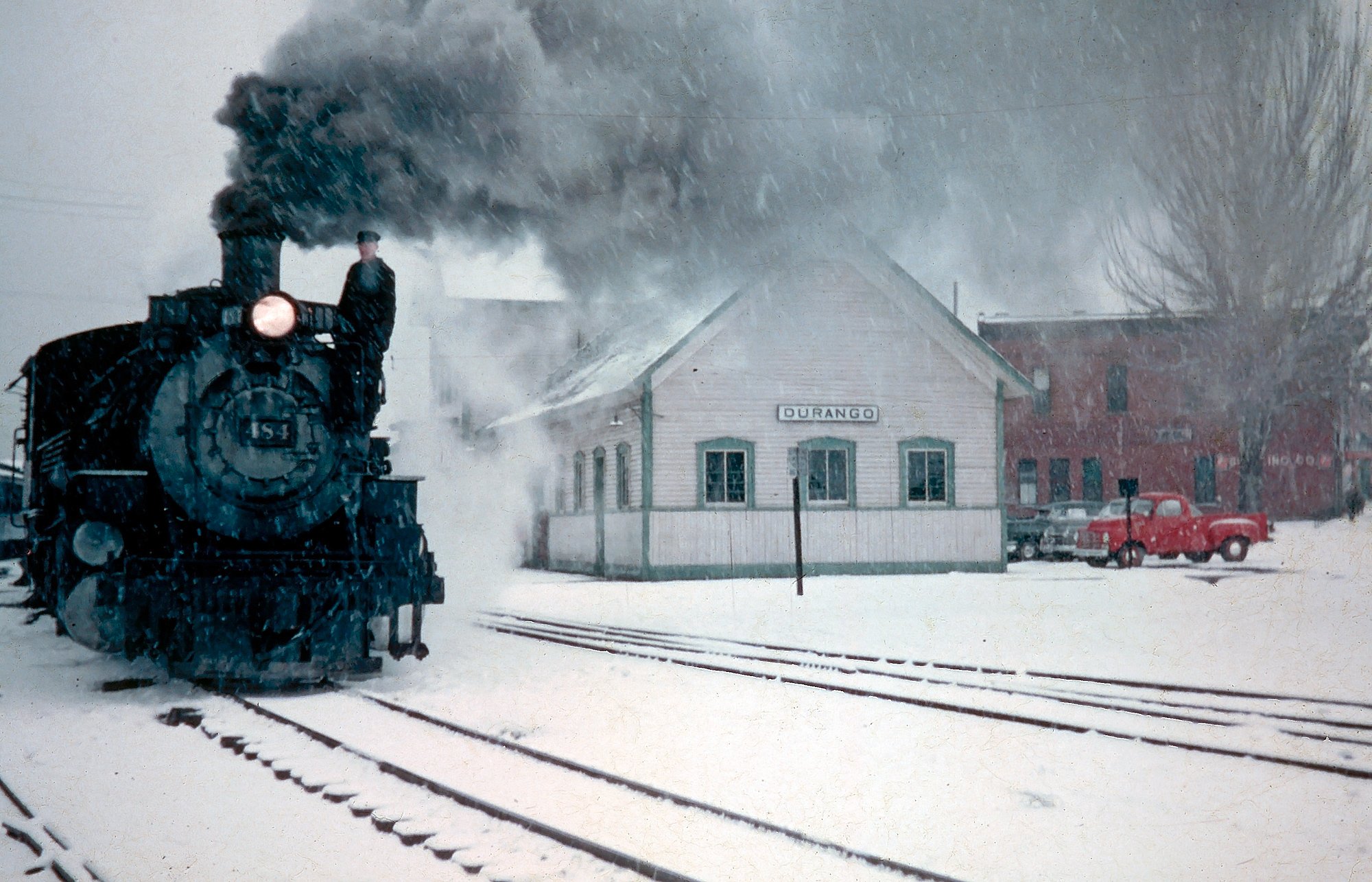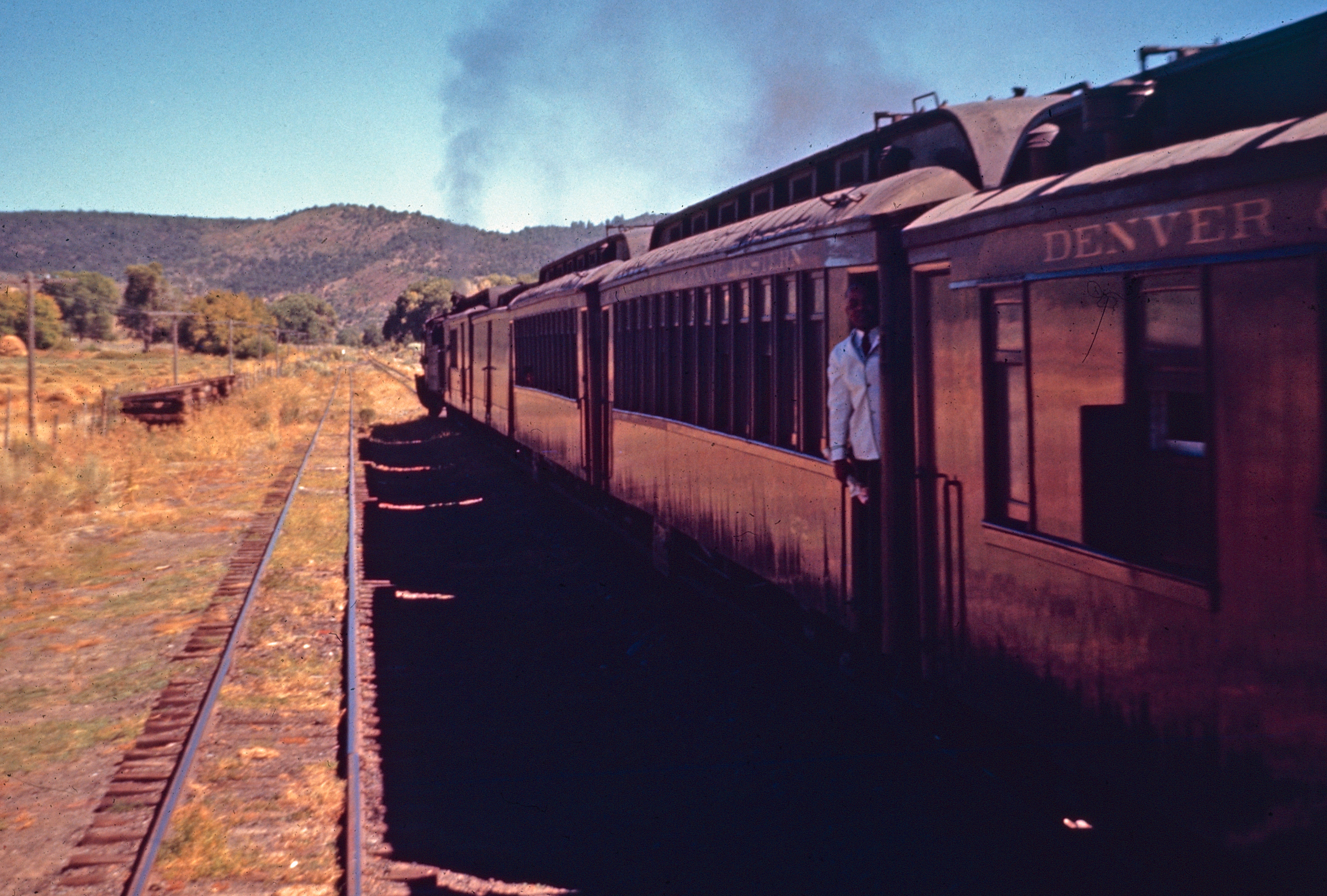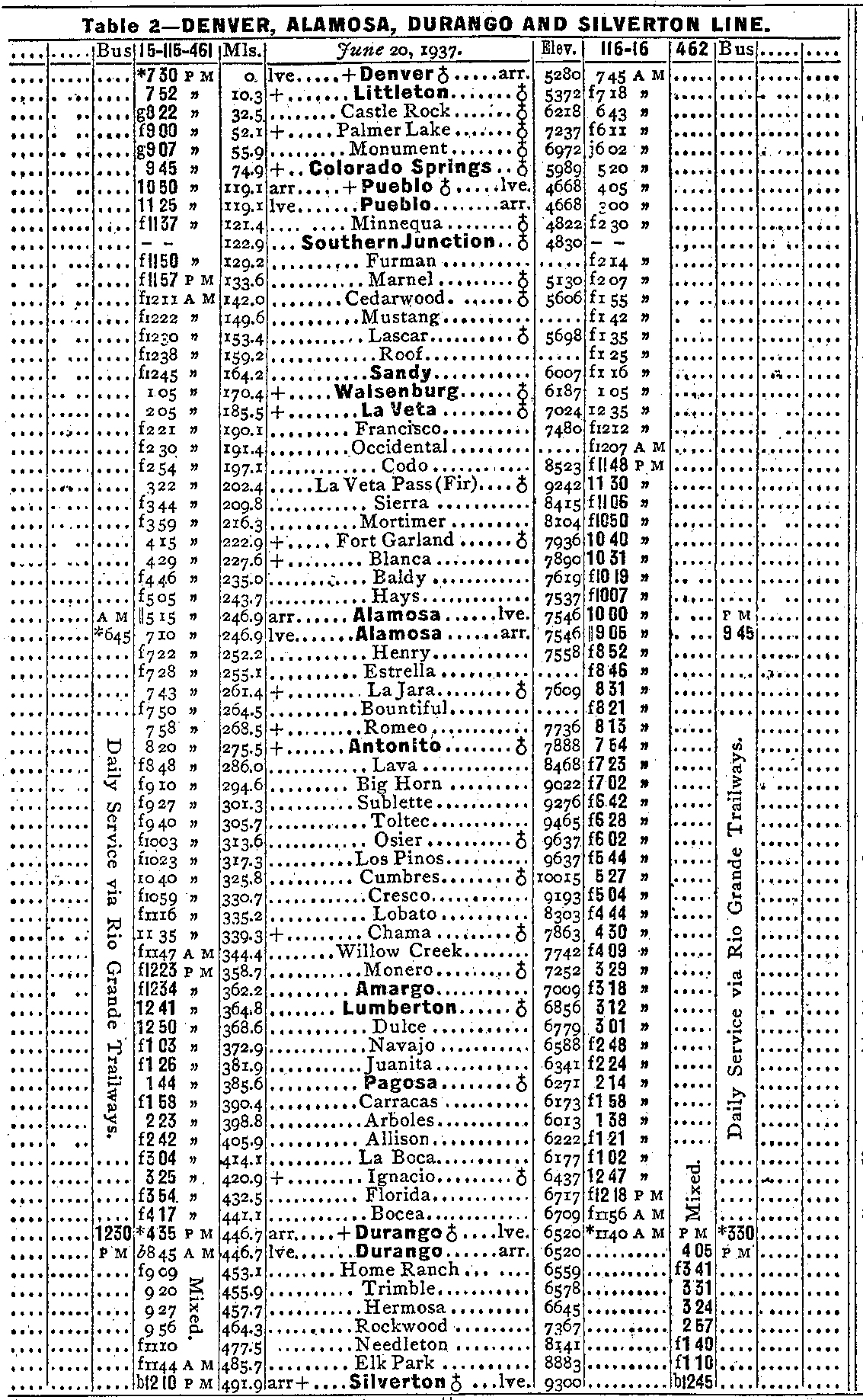"San Juan Express" (Train): Consist, Timetable, Photos
Last revised: March 2, 2025
By: Adam Burns
The Denver and Rio Grande Western Railroad’s San Juan Express was more than just a passenger train; it was a vital thread woven into the fabric of early 20th-century Southwestern America.
Recognized for its picturesque routes and essential service connecting remote areas, the San Juan Express has left an indelible mark on rail and regional history.
The train served the railroad's fabled narrow-gauge San Juan Extension between Alamosa and Durango.
While a section of this line is now abandoned most is still operated by the Durango & Silverton Narrow-Gauge as well as the Cumbres & Toltec Scenic. This article dives into the history, operation, and legacy of this iconic train.
 Rio Grande 2-8-2 #484 has one of the final runs of the "San Juan Express" at Durango, Colorado in late January of 1951. Robert LeMassena photo. American-Rails.com collection.
Rio Grande 2-8-2 #484 has one of the final runs of the "San Juan Express" at Durango, Colorado in late January of 1951. Robert LeMassena photo. American-Rails.com collection.Origins
The origins of the San Juan Express date back to the late 19th century with the Denver and Rio Grande Western Railroad (D&RGW).
Founded in 1870, the D&RGW was instrumental in shaping the western United States, particularly Colorado, Utah, and New Mexico. The ambition of its founders to reach the mineral-rich San Juan Mountains fostered the development of several key routes.
The San Juan Express itself commenced service on February 11, 1937. It was intended to be a faster and more efficient train while maintaining a luxurious and scenic experience for passengers.
It ran from Alamosa, Colorado, through the heart of the San Juan Mountains to Durango, Colorado. In addition, guests could travel through to Denver and/or Farmington/Silverton.
The Route: A Scenic Marvel
One of the most striking characteristics of the San Juan Express was its route. The train traversed some of the most breathtaking landscapes in the American Southwest.
Starting from the high plains of Alamosa, it descended through the narrow, winding tracks of the San Juan Mountains, offering passengers unparalleled views of deep canyons, tall forests, and expansive vistas.
The line from Alamosa to Durango was particularly renowned, winding through the Toltec Gorge and crossing the Continental Divide at Cumbres Pass, an elevation of 10,015 feet.
The route also included the well-known Toltec and Cumbres Passes, where dramatic drops and sharp turns showcased the rugged beauty of the Rockies.
Consist and Rolling Stock
The San Juan Express was operated with narrow-gauge steam locomotives, which were ideally suited for the sharp curves and steep grades of the mountainous terrain.
When first-launched a typical consist included a mix of first-class coaches, a parlor, a standard 16-section sleeper, baggage car, and RPO (Railway Post Office).
One standout feature was the parlor-observation car, which allowed passengers to enjoy the magnificent scenery from large windows and an open observation deck at the rear of the train.
The interior of these cars was designed for comfort and elegance, featuring plush seating and wood-paneled walls, giving travelers a sense of luxury amidst the wild landscape.
The locomotives most commonly associated with the San Juan Express were the K-36 and K-28 class Mikado-type steam engines. These powerful machines were capable of hauling the train through the demanding mountain terrain, delivering reliable and timely service throughout the years.
 Rio Grande 2-8-2 #484 (K-36) has the eastbound "San Juan" traveling along the narrow-gauge San Juan Extension near rural Carracas, Colorado in September, 1944. American-Rails.com collection.
Rio Grande 2-8-2 #484 (K-36) has the eastbound "San Juan" traveling along the narrow-gauge San Juan Extension near rural Carracas, Colorado in September, 1944. American-Rails.com collection.Golden Era
The San Juan Express enjoyed its peak of popularity during the late 1930s through the mid-1940s. It was a vital link for communities along its route, connecting the remote mountain towns with larger commercial hubs.
The train carried more than just passengers; it transported mail, express freight, and goods, making it an essential service for the towns it served.
During World War II, the San Juan Express played a crucial role in supporting the war effort. It facilitated the movement of troops and materials, further embedding itself into the infrastructure of the region.
Despite the tough economic conditions of wartime America, the train maintained its service, underscoring its importance to the region.
Decline and Final Journey
The post-war years brought about significant changes to American transportation. The advent of automobiles and the expansion of the highway system began to draw passengers away from rail travel. Additionally, the increasing popularity of aviation offered faster and often more convenient travel options.
For the San Juan Express, these shifts marked the beginning of the end. Passenger numbers began to dwindle, and maintaining the service became increasingly uneconomical. Despite these challenges, the train continued to operate, steadfastly serving its route until the very end.
The final run of the San Juan Express occurred on January 31, 1951. The cessation of this service marked the end of an era for the D&RGW and the communities it connected. The last trip through the mountain passes wafted with nostalgia and a sense of loss as the beloved train made its final journey.
Legacy
Though the San Juan Express no longer chugs through the mountains, its legacy endures. It is fondly remembered by historians, railroad enthusiasts, and the communities it served.
The train is emblematic of a time when railroads were the lifeline of America's more remote regions, facilitating not just transportation but also communication and commerce.
Today, portions of the old San Juan Express route are preserved and operated by heritage railroads, continuing to offer a taste of the past to tourists.
The Cumbres & Toltec Scenic Railroad, for instance, runs steam trains over part of the original route, from Antonito, Colorado, to Chama, New Mexico. Similarly, the Durango & Silverton Narrow Gauge Railroad offers scenic trips from Durango to Silverton, Colorado, on a section of the historic line.
These heritage railroads not only preserve the physical infrastructure but also the stories and spirit of the original San Juan Express. Passengers on these trains can still experience the awe-inspiring landscapes and sense the historical significance of the rails beneath them.
Timetable (1937)
Conclusion
The San Juan Express was more than just a passenger train; it was a critical artery of life for the communities it connected.
Starting from its inauguration in 1937 until its final run in 1951, the train provided indispensable service, crossing through some of the most beautiful and challenging terrains the American West had to offer.
Today, the spirit of the train lives on through heritage railroads and the memories of those who rode and operated it.
Its story reflects broader themes in American history: the rise and fall of railway dominance, the shifts in transportation technology, and the unyielding allure of the Rocky Mountains.
Recent Articles
-
Missouri's 'Wine Tasting' Train Rides
Dec 12, 25 04:13 PM
The fusion of scenic vistas, historical charm, and exquisite wines is beautifully encapsulated in Missouri's wine tasting train experiences. -
Minnesota's 'Wine Tasting' Train Rides
Dec 12, 25 04:07 PM
This article takes you on a journey through Minnesota's wine tasting trains, offering a unique perspective on this novel adventure. -
Texas - Murder Mystery - Dinner Train Rides
Dec 12, 25 01:06 PM
Here’s a comprehensive look into the world of murder mystery dinner trains in Texas.






